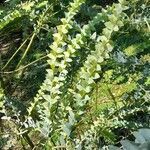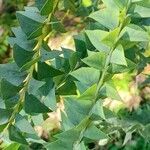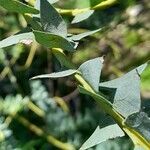Unarmed shrub to c. 4 m. Branchlets regular, glabrous. Phyllodes crowded along branches, coriaceous, lower margin straight or slightly curved, upper margin sharply curved, glabrous, 2-3 by 1-1.4 cm, 2-2.5 times as long as wide, glabrous, gland at or slightly below the broadest part of the phyllode, pustular, with a rather large orifice, main vein close to the lower margin, reticulation penni-veined. Inflorescence consisting of heads of 25-35 flowers in axillary glabrous racemes. Flowers pentamerous, bisexual. Pod flat, glaucous, raised over the seeds, 5-7 by 0.7 cm. Seeds longitudinal, 3.5 by 2.3 mm; areole almost closed, funicle not folded but thickened into a clavate aril beneath the seed.
Unarmed shrub or small tree; young branchlets angular, glabrous. Leaves phyllodic, apparently simple, 0.8-3 x 0.6-1.1 cm, obliquely obovate-lanceolate to ovate-triangular, glaucous, glabrous, with a single main longitudinal nerve and finely penninerved, usually with 1 marginal gland, sometimes on a prominent angle. Flowers in small round heads, arranged in axillary racemes which are longer than the phyllodes and are often ± aggregated terminally. Pods 5-9 x 0.5-0.7 cm, linear-oblong, glabrous, longitudinally dehiscent.
Leaves glaucous, phyllodic, apparently simple, 0.8-3 x 0.5-1.1 cm., obliquely obovate-lanceolate to ovate-triangular with the apex of the triangle on the upper margin, glabrous.
Flowers yellow, in heads arranged in axillary racemes which are larger than the leaves and often ± aggregated terminally.
Shrub, unarmed; young branchlets glabrous, angular.




